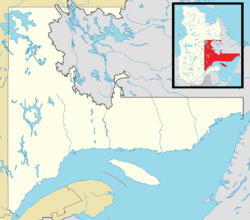Caniapiscau, Quebec
| Caniapiscau | |
|---|---|
| Unorganized territory | |

Caniapiscau Reservoir
|
|
| Location in Côte-Nord Region of Quebec | |
| Coordinates: 54°52′N 69°55′W / 54.867°N 69.917°WCoordinates: 54°52′N 69°55′W / 54.867°N 69.917°W | |
| Country |
|
| Province |
|
| Region | Côte-Nord |
| RCM | Caniapiscau |
| Constituted | unspecified |
| Government | |
| • Federal riding | Manicouagan |
| • Prov. riding | Duplessis |
| Area | |
| • Total | 39,985.70 km2 (15,438.57 sq mi) |
| • Land | 34,057.11 km2 (13,149.52 sq mi) |
| Population (2011) | |
| • Total | 0 |
| • Density | 0.0/km2 (0/sq mi) |
| • Pop 2006-2011 |
|
| • Dwellings | 0 |
| Time zone | EST (UTC-5) |
| • Summer (DST) | EDT (UTC-4) |
| Highways | No major routes |
Caniapiscau is a vast unorganized territory in the Côte-Nord region of Quebec, Canada, part of Caniapiscau Regional County Municipality.
The territory is home to the huge Caniapiscau Reservoir, the largest body of water in Quebec. The reservoir was named after Lake Caniapiscau that was flooded in 1981 during the formation of the reservoir. The name comes from the Cree or Innu term kaniapiskau or kaneapiskak which means "rocky point" or "place where there is a rocky point". Albert Peter Low had noted in 1895 that "a high rocky headland jutts into the lake." He probably referred to the northwest facing peninsula that gives the reservoir the shape of an arc as we know it now.
In the 19th century, Lake Caniapiscau was frequented by hunters and fur traders. In 1834, the Hudson's Bay Company opened there an outpost to link its facilities in the James Bay region with those of Ungava Bay. The Kaniapiskau Post closed its doors in 1870.
Caniapiscau (54°52′4.1″N 69°50′10.5″W / 54.867806°N 69.836250°W) is a small community without a permanent population, just north of the Caniapiscau Reservoir. It was formed as a temporary worksite in 1974 for workers involved in the construction of the dams and floodgates of this reservoir. The reservoir was built as part of the James Bay Project that gave rise to the La Grande hydroelectric complex.
...
Wikipedia

